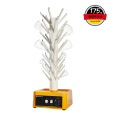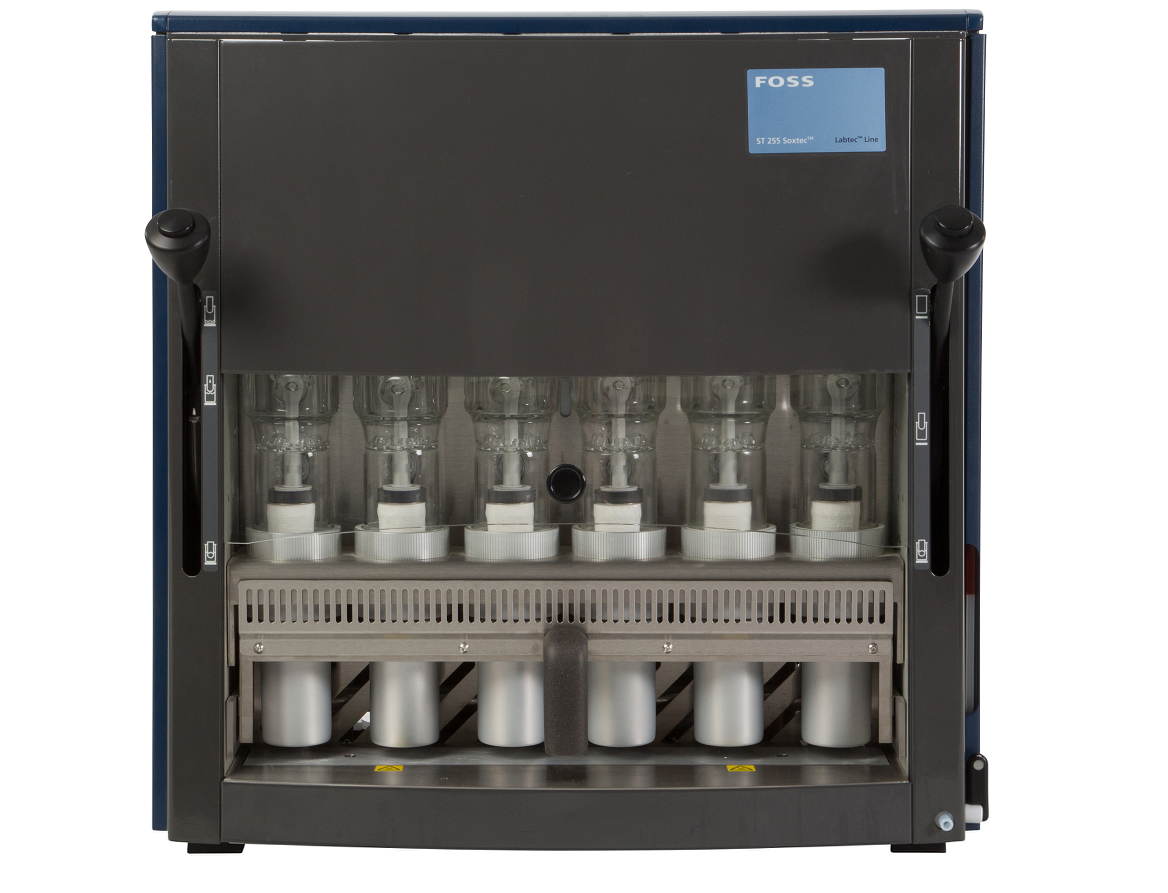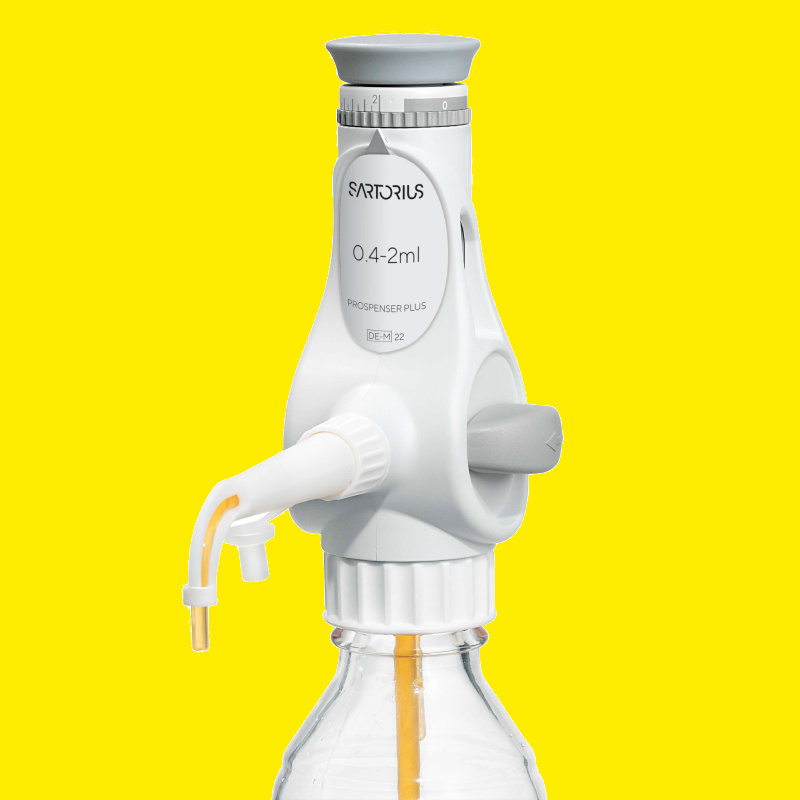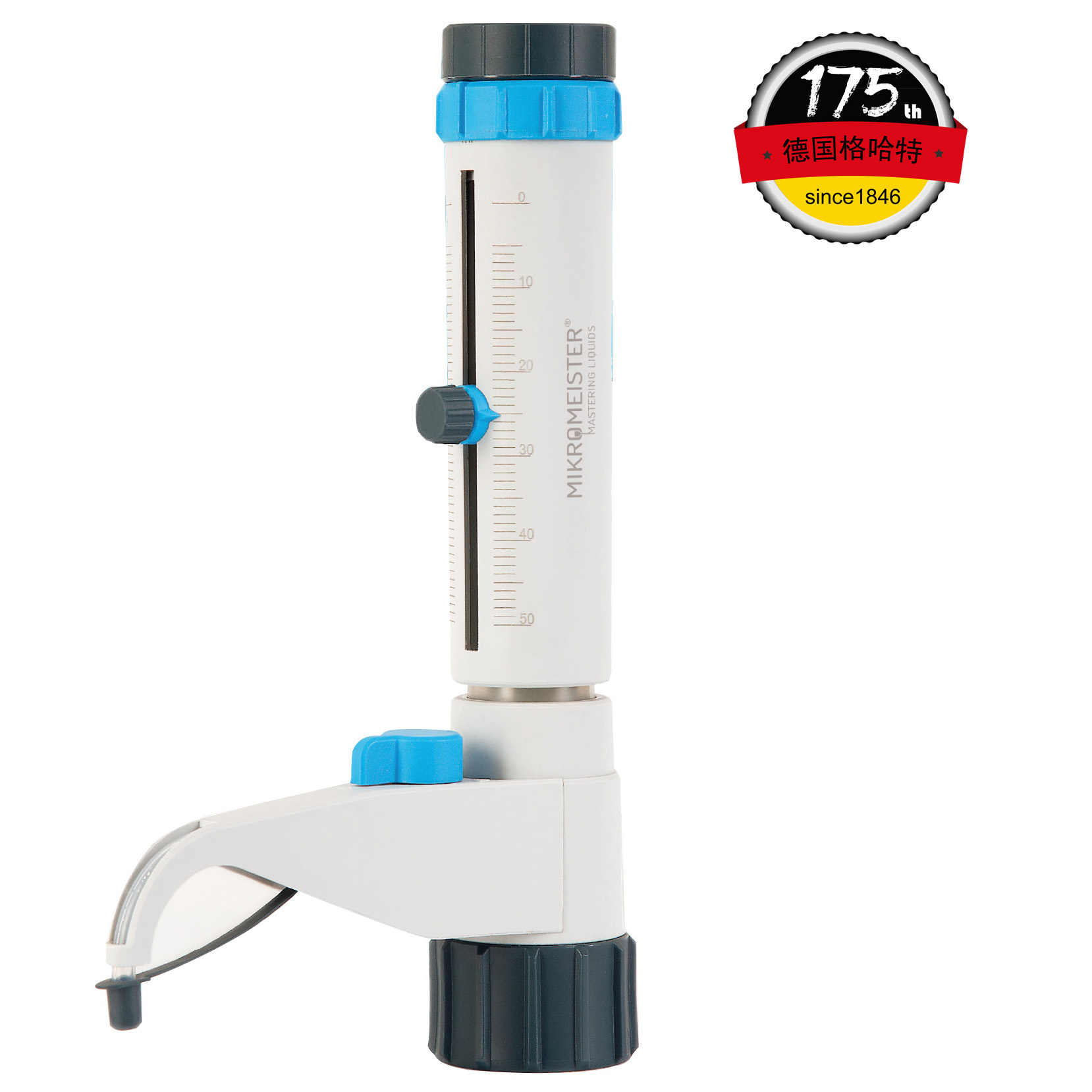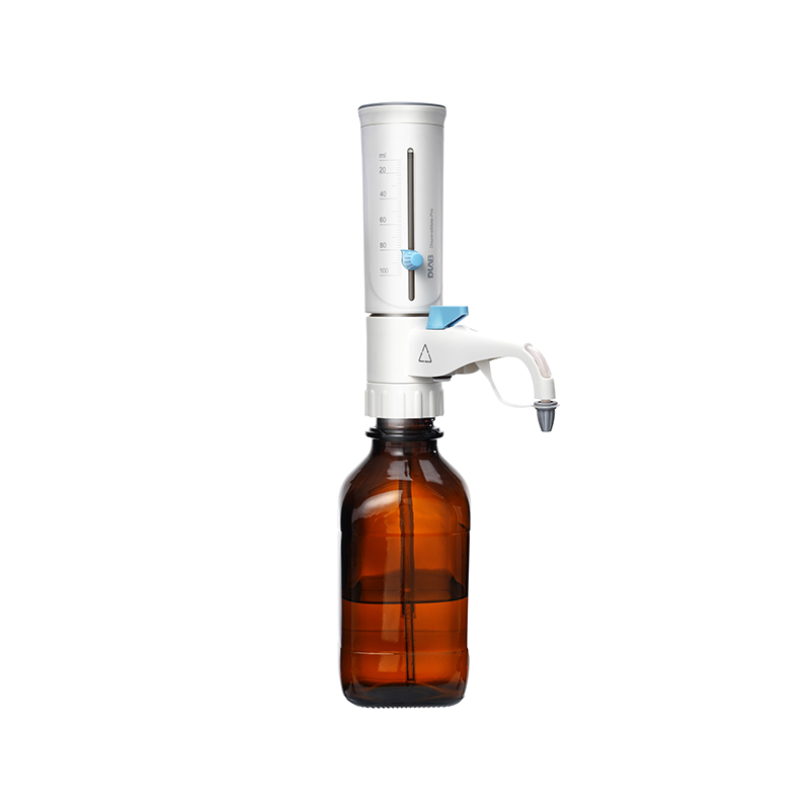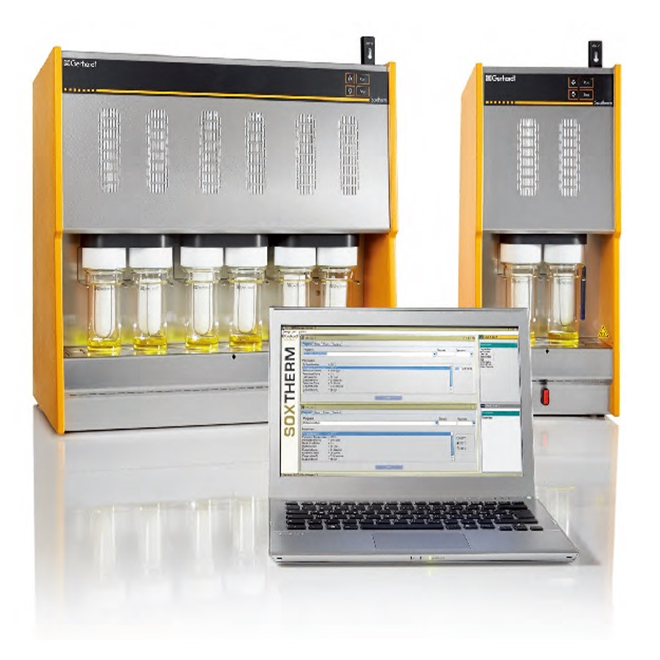
不同浓度施用植物生长促进激素生长素草-3-乙酸(IAA)和细胞分裂素6-苄基氨基嘌呤(BAP)对油菜种子产量和油质的影响Effect of IAA and BAP application in varying concentration on seed yield and oil quality of Guizotia abyssinica (L.f.) Cass
3g样品提取2小时
We obtained niger seed oil by SOXTHERM® extraction (in duplicate) using hexane. Seeds were pulverized into a fine powder using an electrical grinder, then packed (3 g) in cellulose extraction thimbles . Duplicate thimbles were placed in an extractor and hot (60–70 °C) solvent hexane
(1:4 w/v) was percolated continuously for 2 h.
方案详情

不同浓度施用植物生长促进激素生长素草-3-乙酸(IAA)和细胞分裂素6-苄基氨基嘌呤(BAP)对油菜种子产量和油质的影响Effect of IAA and BAP application in varying concentration on seed yield and oil quality of Guizotia abyssinica (L.f.) Cass3g样品提取2小时We obtained niger seed oil by SOXTHERM® extraction (in duplicate) using hexane. Seeds were pulverized into a fine powder using an electrical grinder, then packed (3 g) in cellulose extraction thimbles . Duplicate thimbles were placed in an extractor and hot (60–70 °C) solvent hexane(1:4 w/v) was percolated continuously for 2 h.Annals of Agricultural Sciences 67 (2022) 15-23ELSEVIER M. Talukdar, D.K. Swain and P.B.S. BhadoriaAnnals of Agricultural Sciences 67 (2022) 15-23 Contents lists available at ScienceDirect Annals of Agricultural Sciences journa l homepage: www.elsevier .com/locate/aoas 不同浓度施用植物生长促进激素生长素草-3-乙酸(IAA)和细胞分裂素6-苄基氨基嘌呤 (BAP)对油菜种子产量和油质的影响 Original Article Effect of IAA and BAP application in varying concentration on seed yield and oil quality of Guizotia abyssinica (L.f.) Cass Monaswita Talukdar, Dillip Kumar Swain *, Pratap Bhanu Singh Bhadoria Agr i cultural and Food Engineering Department , I ndian I nstitute of Technology, Kharagpur , I ndia Ar t icle history: Received 8 August 2021Received in revised form 9 February 2022Accepted 24 February 2022Available online 16 March 2022 Keywords: Fatty acid Niger seed yield Indo l e-3-acet i c ac i d 6-Benzyl aminopurine Oil content 1.Introduction The exponential growth of the global population is i ncreasing t he pressure on agricultural productivity. The present food supply com-prises a few main crops grown under maintained agricultural condi-tions, along with various minor crops. These minor crops should not be underestimated, especially when they are equall y useful for food and industrial purposes and can be cultivated with minimal i nput. Human dietary input generally consists of carbohydrates, proteins,and numerous micronutrients such as vitamins, minerals, and antioxi-dants. As rich sources of energy and nutrition, oilseeds can provide an adequate amount of micronutrients. Thus, they play important r oles in maintaining human health. Interest i n novel sources of edi b le oil has r e-cently increased because no oil from any single source has been found suitable for all edible and non-edible appl i cations. Among novel sources of edible oil , niger (Guizotia abyssinica (L.f.) Cass.) seed oi l might play an important role i n human nutrition and health owing t o i ts fatty acid composition and abundant fat-soluble bioactive components (Ramadan and Moersel, 2002a,2002b). Guizotia abyssinica (L.f.) Cass., also known as niger or ramtil, i s an an-nual dicotyledonous oil seed crop belonging to the family of Asteraceae. * Corresponding author. E-mail address: swain@agf e .iitkgp.a c.i n (D.K . S wain). It originated i n Ethiopia and i s now established in I ndia. The plant grows to an average height of 0.5-1.5 m and reaches maturity i n 95-110 days.Niger seed plan t flowers are yellow with a head diameter of 15-50 mm and ray florets of 5-10 mm. The f lowering of an i ndividual with 40 seeds takes about 8 days (Getinet and Sharma, 1996). Peripheral shiny black seeds general l y become more vigorous and mature t han central and in-termediary seeds and weigh 3-5 g. The t ypical developmental order might occur due to poor vascularization in the central flower head.Niger seeds contain 32-38% oil and 18-22% protein, and along with pro-viding nutrition to humans and animals, it is used i n the pharmaceutical and biofuel industries, among others. The fatty acid composition of the niger seed plant resembles that of safflower (Carthamus tinctorius)and sunflower (Helianthus annuus), which contain up to 85% linoleic acid (C18:2n-6) (Ramadan and Moe r sel, 2003). Other predominant fatty ac i ds include palmitic (C16:0), stearic (C18:0), and oleic (C18:1n-9) acids. Niger seed plants are usually grown in the Kharif sea-son (June to the end of October) and are c r oss-pollinated v ia a f loral mechanism and honeybees. Niger seed plants require a full dry spell during flowering and seed setting; rainfall at this stage i s detrimental and can lower seed yield (Dalei et al., 2014). Abscission induction a nd several other physiologica l factors can also lower flower production,empty achenes and resul t i n poor seed setting. Crop yield is generally i n-creased by prevent i ng losses caused by weather or insects, accelerating crop production cycles, or applying various hormones t hat promote plant growth. Recent studies have revealed that plant growth regulators (PGRs ) play important roles in flower development and consequent seed yield (K r izek and Fletcher, 2005; Santner et al., 2009). Non-toxic auxins are versat i le hormones that can be used as PGRs. Very low auxin concentrations might regulate cell division, elongation, adventi-tious root formation, callus i nitiation, and i nduction of embryogenesis.Indole 3 acetic acid (IAA) i s the most prevalent auxi n in plants; it affects cel l division, root i nitiation, flowering, fruit setting, ripening, senes-cence, and gravitropism. The cytokinin 6-benzyl aminopurine (BAP)promotes plant growth and plays critical roles i n whole pl a nt ontogeny,including cell division, photomorphogenic development, metabolism modulation, seed, and pod set t ing, senescence, death, and responses to environmental stimulants (Chernyad'ev, 2000; Hirose et al.,2007).Spraying the fol i age with 2.5 ppm of IAA results in t aller summer squash plants and i mproved f ruit yield. In contrast, IAA at 5 and 10 ppm re-duced both the height and yield of this plant (Nassef and El-Aref,2018). Exogenous IAA up to 1 mg L -1 increases the growth and seed yield of linseed (Linum usitatissimum L .), whereas 2 mg L -1 has the op P --posite effects (Rastog i et al., 2013). At 50 mg L-1, IAA maximizes t he growth of Epipremnum aureum whereas 5 and 100 mg L-1 both result in smaller plants (D i Benedetto et al., 2015). Mungbean branc h ing is negatively affected by increasing concentrations of exogenous auxin (El Karamany et al., 2019). Exogenous CKs, especially BAP, i ncrease the activity of inflorescences i n plants (Werner and Schmulling, 2009).Exogenous cytokinin promotes plant growth and yield characteristics Leaf area development is promoted by BAP up to 100 mg L-1. Spraying E. aureum with BAP at any concentration significantly increases the rate of relative l eaf area expansion (RLAE) and plant growth as well as devel-opment f rom cut ti ngs (Di Benedetto et al., 2013). Gandolfo et al.(2014)reported that BAP up to 50 mg L-1 positively i nfluenced t he growth of Impatiens wallerana, whereas concent r ations up to 100 mg L -1n ega-tively influenced growth. Cytokinins support female reproductive organ development in some plants (Yuan et al., 2016; Cheng et al.,2013). Auxins and cytokinins associate with each other i n a complex way to support plant growth and di f ferentiation. Di Benedetto et al.(2015) found that IAA and BAP up to 50 mg L -1 similarly promote pl a nt growth. Simultaneously applied auxins and cytokinins exert an-tagonistic effects (Jones et al., 2010; Tanaka et al., 2006; Shimizu-Sato et al.,2009). However , the mechanism of i nterpreting the effects of these combined hormones on the ent i re plant i s unclear. The present study aimed to determine the effects of an auxin and a cytokinin on niger seed plant growth, seed yield, and oil quality when cult i vated i n laterit i c soil. 2. Materials and methods 2.1. Experimental site Niger seed plants were cultivated in pots at the Exper i mental Farm of Agricultural and Food Engineering Department at the Indian Institute of Technology, Kharagpur, India (22°19' N and 87°19' East longitude)during the wet seasons (June to September) of 2014 and 2015. T he climate of this region is humid and subtropical . The average annual rainfal l is 1640 mm, 70% of which f alls during the rainy season (June-September ). The average annual daily temperature ranges from 21℃to 38C. The daily average temperatures varied from 35℃ to 29℃and 33 ℃ to 30°C between June and September i n 2014 and 2015, re-spec t ively, and the amount of rainfal l was 780 and 1173 mm, r espec-tively. The acid l ateritic (Haplustal f ) soi l at the site has a sandy loam texture comprising 62% sand, 24% s i lt, and 14% clay mixed with lateritic pebbles. Table 1 shows the most important soil properties. 2.2. Pot experiments We i nvestigated the effects of spraying niger seed plants with 25,50,75, and 100 mg L-1 each of IAA and BAP individually with 50, 75, and Table 1 Physical and chemical properties of soi l of experimental site (0-20 cm). Parameters Value Physical properties Bulk density, mg m-3 1.64 Chemical properties: 5.49 DH 0.36 Organic C,% Available N. kg ha-1 143.03 Available P. kg ha-1 10.87 Available K, kg ha-1 100 mg L -1 of both combined, on plant growth and the quality of niger oi l . Control plants were sprayed wi t h water. A total of 18 applica-tions with 3 replications proceeded in 54 earthen pots (diameter,30 cm; depth, 60 cm) using a Complete Randomized Design (CRD).About 10 seeds were sown in each pot under natural conditions at a depth of 3 cm to ensure three plant s per pot at harves t. The soil moisture in each pot was maintained at a constant l evel. 2.3. Application of IAA and BAP We applied 25, 50,75, and 100 mg L-1 each of IAA and BAP, and 50,75, and 100 mg L-1 of both i n combination. Stock solutions of IAA and BAP (both 25 mg mL -1) were prepared by dissolving 1 g each i n 5 mL of 1 N NaOH and bringing the volume up t o 40 mL with molecular biol-ogy grade water. Tween 20 (Polysorbate 20;0.05%v/v) was added as a wetting agent to all working solutions of BAP. The hormones (~100mL)at the described concentrations were hand-sprayed onto the plants every 3 days start i ng from 15 days after sowing (DAS) dur i ng t he advent o f vegetative growth, for 90 DAS when the plants flowered. The plants were temporarily covered with transparent plastic sheets to avoid hor-mones drift i ng to nearby plants. Control plants were sprayed with 100mL of dist il led water. No other type of fer til izer was added to the pots. 2.4. Crop growth assessment Plant height , dry matter production, the number of branches and ca-pitula per plant, and the number of seeds per capitulum were assessed at the time of harves t . The biomass obtained from each oven-dried pot was weighed to calculate the dry yield. 2.5. Oil extraction We obtained niger seed oi l by SOXTHERM@ extraction (in duplicate)using hexane (B hatnagar and Krishna, 2013). Seeds were pulver i zed i nto a f i ne powder using an electrical grinder, then packed (3 g) i n cel l ulose extraction thimbles (Whatman, Maidstone, UK). Duplicate thimbles were placed i n an extractor and hot (60-70℃) solvent hexane (1:4 w/v) was percolated cont i nuously for 2 h. 2.6. Fatty ac i d composition The fatty acid composition of oil samples was analyzed by gas chro-matography using a Model GC-2010 Plus-02 instrument (Shimadzu Corp., Kyoto, Japan), equipped with a hydrogen f lame ioni z ation detec-tor (FID). The oil was trans-esterified into fatty acid methy l esters (FAMEs) using methanolic KOH according to AOCS Method No: Ce 1-62 (Firestone, 1998) and separated using a column (30 mx0.32 mm di-ameter) at an i nit i al temperature of 140 ℃ that was gradually increased to 240℃ at 4℃ min -1 i ntervals. The flow rate of the carrier gas, nitro-gen, was maintained 3 mL/min. Fatty acids in the samples were i dent i -fied based on the retention time of the reference standard FAME mix C8-C24 (Supelco In., Bel l efonte, PA, USA) and are expressed as relative areas %. 2.7. Statistical analysis Data were s t atistically analyzed as described by Gomez and Gomez (1984). Al l parameters were analyzed using R software. Dif f erences be-tween means were compared using Duncan multiple range tests (P 0.05). 3. Results 3.1. Height Plant height significantly i ncreased along with IAA concentrations from 25 to 75 mg L -1 i n 2014 and 2015 (Fig. 1), whereas 100 mg L-1significantly reduced (ps0.05) plant height i n both years to a level that was below that of control plants (IoBo). Plants reach a maximum height of 121 and 124 cm when sprayed with 75 mg L -1 of IAA in 2014 and 2015, respectively. Fig. 1. Ef f ec t of I AA, BAP and the i r combined appl i cat i on on plant height of niger at matu-r ity i n the year 2014 and 2015 IAA: Indole-3-acetic acid; BAP: Benzyl aminopurine. We also found that BAP (25-75 mg L-1) significantly increased the height of niger seed plants i n 2014 and 2015 (F ig . 1). Plant height reached maxima of 140 and 156 cm when sprayed with 75 mg L -1BAP in 2014 and 2015, respect i vely. Plant height was statist i cally the same both years when sprayed with 25, 50, and 100 mg L-1 BAP. Con-trol plant height was minimal at 89 and 88 cm. Spraying with combined I AA and BAP dif f erently affected plant height i n 2014 and 2015 (F i g. 1).Significant difference i n plant height was observed between control (sprayed with water) and combined hormonal treatments (Fi g.2). In general, plant height significantly i ncreased as t he concentration of BAP increased, while that of IAA remained constant. Spraying the plants with combinations of IAA 75 mg L-1 and BAP 100 mg L-1(I7sB100),and IAA 50 mg L -1 and BAP 100 mg L -1(IsoB100), respectivel y achieved maximum heights of 153 (2014) and 147 (2015) cm. Combinations of IAA and BAP at 75,50, and 100 and 75 and 100 mg L-1 (IsoB75, IsoB100,I7sB1o0) similarly achieved maximal plant heights in both years, which were significantly higher than those achieved by spraying with any other combinations. Pl a nt height reached 84 and 73 cm in 2014 and 2015, respectively, when sprayed with I100B5o- 3.2. Above-ground biomass Above-ground biomass was significantly i ncreased by IAA 75 mgL-over controls (Fig.3). The biomass wa s maximal at 23 and 29 g per plant sprayed with 75 mg L-1 of IAA. The effects of 25, 50, and 75 mg L-1IAA on biomass formation were simi l ar in both years. The biomass per plant was minimal in control plants sprayed with IoBo. Spraying with BAP (75 mg L-1) signi f icant l y i ncreased above-ground biomass formation to maxima of 29 and 30 g per plant compared with any other concentrations (F i g.3). Biomass formation was simi l ar in both years when plants were sprayed with 25 and 50 mg L -1 of BAP. However, biomass formation decreased more by BAP 100 mg L -1 than by 75 mg L -1. The biomass was minimal in control plant s sprayed with IoBo- Fig.3 shows the effects of spraying plants with combined IAA and BAP on above-ground biomass in 2014 and 2015. Biomass production per plant increased with increasing concentrations of BAP and a con-stant concentration of IAA. The biomass of 38 and 40 g per plant was maxima l when sprayed with IsoB100 in 2014 and 2015, r espectively.The amounts of biomass per plant generated by spraying with I s oB100and I 7sBioo were comparable and significantly higher than other combinations in both years. 3.3. Number of branches Spraying with IAA in general inhibited branch f ormation i n 2014 and 2015 (Table 2). Increasing IAA concentrat i ons significantly decreased the numbers of primary branches f ormed in both years. T he numbers of primary branches per plant were maximal at 12 and 15 in 2014 and 2015 respectively, when sprayed with IAA I 2sBo, and minimal both years when sprayed with I1ooBo. Secondary branch formation was comparable in I 2sBo and I s oBo and significantly higher t han I 10oBo. In contrast to IAA, spraying plants with BAP up t o 75 mg L-1in-creased primary and secondary branch formation (Table 2). The num-ber of primary branches reached a maximum of 23 and 25 per plant when sprayed with IoB7s in 2014 and 2015, respectively. Secondary branch formation i n IoB25, IoBso, and I oB1oo was comparable i n 2014and significantly lower than IB7s. Spraying the plants with combined IAA and BAP significantly af-fected branch formation (T a ble 2). I ncreasing the BAP concentration from 50 to 100 mg L-1 significantly increased branch formation when IAA remained constant in both years. T he number of pr i mary branches of 18 and 15 per plant was maximal when the plants were sprayed with IsoB1oo in 2014 and 2015, respectively. Secondary branches formed in IoB7s, IsoB100 and I 7sB100 were comparable and significantly Fig. 2. Effects of hormones on niger plant growth at 30 DAS. Plants sprayed with (a) water (control) and (b) hormones. higher than the other concentrations. Spraying the plants with I 10oB50resulted in minimal pr i mary and secondary branch formation. 3.4. Capitulum formation The numbers of capitula per plant were significantly i nfluenced by IAA in 2014 and 2015 (Table 3). The maximal numbers of capitula formed per plant sprayed with IAA I soBo were 51 and 59 during 2014and 2015, respectively. Capitula formed i n plant s were comparable during 2015 and signi f icant l y lower when sprayed with I oBo and I 25Bo than any other IAA concentrat i ons. Increasing concentrations of BAP up to 75 mg L-1 during 2014and 2015 significantly i ncreased capitulum format i on, whereas 100 mg L- (I oB100) significantly lowered it i n 2015, despite being comparable during 2014. Among the BAP concentrations, l o B7s yielded maximal capitulum formation (79 and 81 i n 2014 and 2015, respectively). Spraying the plants with IAA and BAP significantly affected capitu-lum formation during 2014 and 2015 (Table 3). The numbers of capi t ula were maximal at 83 and 85 when sprayed with I soB1o0 i n 2014 and 2015, respectively. The numbers were comparable between I s oB100and IoB7s in 2015, but significantly better t han any other hormone concentrations in both years. Capitulum formation was minimal i n plants sprayed with I10o Bso i n both years. 3.5. Number of seeds per capitulum Spraying with IAA significantly affected seed formation (Table 3).The maximum number of seeds per capitulum was maximal at 26 and 30 in 2014 and 2015, respectively when sprayed with IsoBo. Seed formation in I s oBo and I 7sBo was comparable in both years and significantly higher than any other hormone concentrations. Minimal numbers of seeds formed with I100Bo- Seed formation gradually increased with increasing BAP concentra-tions up to 75 mg L -1 during 2014 and 2015 (Table 3). The numbers of seeds were maximal at 37 and 44 during 2014 and 2015, respectively,when plants were sprayed with IBzs and significantly higher than any other BAP concentrations. Spraying with combined IAA and BAP significantly affected seed pro-duction (Table 3). The numbers of seeds were maximal at 44 and 48during 2014 and 2015, respectively, when plants were sprayed with IsoB1o0. The numbers of seeds per capitulum were comparable betwee n I soB1oo and I B7s dur i ng 2015, and significant l y higher than any other combinations. Minimal numbers of s eeds formed when plants were sprayed with I 1ooB5o in both years. 3.6. Seed yield Table 3 shows the effects of IAA and BAP on niger seed yield. The maximum seed yields of plants sprayed only with IAA (IsoBo) were 4.38 and 4.41 g plant -1 i n 2014 and 2015, r espectively. I ncreasing the BAP concentration f rom 0 to 25, 50, and 75 mg L-1significantly increased seed yield during both years (Table 3). The seed yield of 10.46 and 10.30 g plant -l was maximal with I oB7s in 2014 and 2015, respectively. The seed yield was significant l y l ower f or IoB1oo than IoB75- Spraying plants with a combination of IAA and BAP significantly af-fected seed yield in 2014 and 2015 (T able 3). Seed yield s of 13.24 and 12.67 g plant- were maximal for IsoB1oo during 2014 and 2015,respectively. Moreover, the seed yield of IsoB1oo was signi f icantly higher than that of any other concentrat i ons during both years. The seed yield was the lowest with 11oo Bo in both years. 3.7.Oi l content Spraying with IAA significantly i nfluenced the oil content of niger seed during 2014 and 2015 (Table 4). Up to 100 mg L-1 of IAA did not significantly change oil content, whereas an increase in BAP up to 50 mg L -1 significantly increased the oil content dur-ing both years. The maximum oi l content of 36.88% and 37.48% was achieved with BAP 50 mg L-1(IoBso) in 2014 and 2015,respectively. The combination of I s oB75 and/or IsoB1oo yielded maximal oi l content comparable with IoBso in both years. The oil content s of 32.87% and 32.51% were minimal with I 1ooBso in 2014and 2015, respectively. Fig. 3. Effect of IAA, BAP and their combined application on above ground biomass (g per plant ) of niger at harvest i n t he year 2014 and 2015IAA: Indol e -3-acetic acid; BAP: Benzyl aminopur i ne. 3.8. Fatty acid contents Spraying plants with IAA and BAP significantly affected the saturated (palmitic and stearic acids) and unsaturated (ole i c and linolei c acids)fatty acid contents of niger oil during 2014 and 2015 (Table 5).Increasing the IAA concentration from 25 to 75 mg L -1 significantly i n-creased the palmitic acid content in both years. The palmi t ic acid contents of 75 and 100 mg L- were comparable during 2014 and were significantly higher t han those of plants sprayed with 25and 50 mg L -1 IAA. Increasing the BAP concentration f rom 25 to 75 mg L-1 significant l y i ncreased palmit i c ac i d content s in both years. The palmitic acid contents yie l ded by spraying with 75 and 100 mg L -1 BAP were comparable in both years and wer e significantly higher than those at 25 and 50 mg L -1 BAP . The palmitic acid content s were maximal (13.41% and 13.36%) and minimal (7.21% and 7.11%)when plants were sprayed with the combination of I1ooB1o0 and with 25 mg L -1 of BAP alone during 2014 and 2015, respectively. The s tearic ac i d contents of niger seed oi l wer e significantly i ncreased by individual IAA and BAP concentrations up to 75 and 100 mg L-1, respectively, Table 2 Ef f ect of IAA, BAP and their combined applicat i on on branch formation of niger i n t he year 2014 and 2015. Hormone conc. (mg L-1) Primary branches Secondary branches 2014 2015 2014 2015 IoBo 13±1cde 16±1d 23±2 24±2d I2sBo 12±1de 15±1cd 22±14 23±14 IsoBo 11± 2def 14±2cder 21±1 22±1 I7sBo 11±1def 12±1efg 18± 2def 21±1de I100Bo 8±1fghi 11±1fg 16±3efg 18±1ef IoB25 14±1°d 17±1 33±2 33±2 loBso 18±2b 20±1b 37±2b 40±2b IoB75 23±2 25±2 45±4 47±1 loB100 16±2bc 22±1ab 37±3b 40±1b IsoBso 10±1efgh 10±1gh 19±2def 24±3d IsoB75 13±2d 13±2der 33±2b 36±4 IsoB100 18±2b 15±3*d 46±3 48±4 I7sB5o 8±1ghi 7±2h 18± 3def 24±3 I7s B75 8±2ghi 8±2h 20±3de 22±1 I7sB100 14±3*d 14±2def 43±3 51±2 I100B5o 5±2 7±2h 12±25 14±2号 I100B75 7±3hi 11±4 15±3f 17±3 I100B100 11±3defg 15±2cde 27±3 34±4 I : indole-3-acet ic acid; B: benzyl aminopurine; values are mean ± SD; mean values shar -ing sim i lar letter within a column are non-signi f icant at P ≤ 0.05 accordi n g to Duncan's multiple range test. Bold values signify the highest number of pr i mary branches among all the treatment combinations. during both years. Spraying with the combination of I 75B100 BAP, maxi-mized the stearic acid contents to 10.84% and 10.82% during 2014 and 2015, respectively. The stearic acid contents of I7sBioo and 1100B100were comparable during 2015 and were significant l y higher than any other individual and combined concentrations. Table 5 shows that IAA concentrat i ons up to 50 mg L-1 significantly i ncreased oleic acid con-tents i n 2014 and 2015. The oleic acid contents of 42.44% and 44.33% were maximal in 2014 and 2015, respectively, when plants were sprayed with 50 mg L -1 IAA (Is oBo). Spraying with 50, 75 or 100 mg L-1 IAA yielded similar oleic acid contents in 2014, but t hese were significantly lower dur i ng 2015. Increasing BAP concentrations to 50 mg L -1 signi f icantly increased oleic acid contents in both years.Spraying with IAA signi f icantly i ncreased the oleic ac i d contents com-pared with BAP. The oleic acid contents of 29.45% and 29.42% were maximal with IsoB1oo, but significantly lower than those yielded by I soBo i n both years. Spraying plants with I7sB100 yielded minimal oleic ac i d contents of 19.68% and 21.21%, respectively, during 2014 and 2015. Linoleic acid contents signi f icantly decreased with i ncreasing IAA and BAP concentrations during 2014 and 2015. The linoleic acid con-tents of 72.96% and 72.84% were maximal with I oBo in 2014 and 2015,respectively. Spraying with combined IAA and BAP significantly affected l i noleic acid contents during 2014 and 2015. The l i noleic acid contents were maximal at 63.06% and 62.87% during 2014 and 2015, respec-tively, when plants were sprayed with IsoBso. The l inoleic acid contents were minimal wi t h I1ooBo and I7sBo during 2014 and 2015,respectively. 4. Discussion 4.1. Effects of various growth hormone concentrations on niger seed plant growth The main type of auxin in plants is IAA, which i s produced in young leaves and the shoot apex of buds. Thi s auxin seems to enhance the growth and development of plants by participating in numerous pro-cesses including cell elongation, meristematic tissue growth, phototro-pism and geotropism, apica l dominance, the introduction of lateral shoots, and vascular tissue differentiation (Tai z and Zeiger, 2006). It i s Effec t of IAA, BAP and thei r combined application on seed yield att r ibutes of niger i n t he year 2014 and 2015. Hormone conc. (mg1-1) No. of capitula per plant No. of seeds per capitula Seed yield per plant (g) 2014 2015 2014 2015 2014 2015 IoBo 43±7 45±3h 24±1gh 26±2zh 2.87±0.4ik 3.09±0.2 I25Bo 43±3 45±2hi 24±18h 27±5fzh 3.04±0.2jk 3.29±0.4 IsoBo 51±28h 59±6de 26±1f 30±1defg 4.38±0.3=h 4.41±0.38h I75Bo 48±1h 54±1ef 25±25 28±1efgh 4.15±0.3=hi 4.00±0.2hi I100Bo 43±卫 50±3f 16±2 19±3 2.17±0.3k 2.32±0.2k IoB25 52±4s 61±2d 29±1ef 32±2cdefg 4.76±0.5= 4.97±0.2f IoBso 66±3de 69±1 31±2de 35± 3bcd 6.78±0.6ef 7.12±0.2d IoB75 79±2b 81±2 37±2b 44±4 10.46±0.7b 10.30±0.4b IoB100 75±3 76±2b 33±2*d 37±3bc 8.13±0.6cd 7.97±0.2 IsoBso 67±2de 70±4 31±2de 36±1bc 7.17±0.7de 6.80±0.6 hd IsoB75 69±2d 75±4 34±3 38±1b 8.24±0.3 8.06±0.1° IsoB100 83±3 85±3 44±4 48±4 13.24±1.5= 12.67±0.6 I7sB5o 56±2f 68±2 26±1% 32±2edef 4.50±0.3sh 5.13±0.3f I75 B75 65±3° 67±3° 29±2f 33±4cde 6.05±0.6f 6.08±0.4° I7sB100 73±3 75±3b 30±2de 35±1bcd 7.02±0.2ef 6.81±0.3 I10oBso 43±3 41±1 16±1 15±1 3.24±0.8 3.57±0.3 I100B75 45±3 45±2hi 21±2h 24±1h 3.55±0.4hi 4.65±0.2fs I10oB100 48±2hi 47±2gh 23±2gh 28±1efgh 3.86±0.2ghij 4.07±0.2hi I: indole -3-acetic acid; B: benzyl aminopurine; values are mean ± SD; mean values sharing similar letter within a column are non significant at P≤ 0.05 according to Duncan's multiple range test . Bold v a lues signify the highest number of capitula per plant , number of seeds per capitula and seed yield per plant among al l the t reatment combinations . also att r ibuted to increased photosynthetic activity, which results in in-creased cell division and the accumulation of saccharides, the building block for plant growth (Naeem et al., 2004). Here, we f ound t hat the height of niger seed plants was significantly increased by spraying with IAA up to 75 mg L -1, whereas 100 mg L-1 negatively i mpacted plan t height. The above-ground biomass also increased f rom an average of 21-26 g per plant when sprayed with I Bo and 75 mg L -1 of IAA over 2 years. Wheat plants sprayed with 100 ppm of IAA yielded the maximal height , whereas 150 ppm reduced the plant height (Hanaa and Safaa,2019). The height of waterme l on plants increases when s prayed with IAA up to 5 ppm, whereas 10 and 20 ppm reduce growth and branch formation (Ogwu, 2018). Auxin signaling mediated by auxin binding protein might have increased t he effic i ency of genes involved in cell 11proliferation through membrane hyperpolarization. Auxins are pr i mar-i ly synthesized i n the shoot apex in young l eaves (Ljung et al., 2001) and Table 4Effec t of I AA, BAP and their combined application on oi l content of niger in t he year 2014and 2015. Oil content (%) 2014 2015 IoBo 34.67±0.4efgh 34.03±0.5efg I25Bo 35.28±0.6bedef 35.55±0.3bedef IsoBo 35.37±0.6bcde 35.82 ±0.2abcdef I75Bo 35.48±0.zabcd 36.01±0.3abcde I100Bo 35.06 ±0.3cdefg 36.22±0.2abcd loB25 36.53±0.4ab 35.97 ±0.5abede IoB50 36.88±0.gab 37.48±0.6= loB75 36.40±0.4abc 36.70±0.7abc loB100 36.25±0.4abe 36.19±0.2abcd IsoB5o 33.65±0.3fgh 35.04±0.5cdef IsoB75 37.12±0.8 37.04±0.6ab IsoB100 36.78±0.5ab 37.47±0.2 I75B50 34.42±0.3efgh 33.96±0.4fg I75 B75 35.12±0.2cdefg 34.89±0.6cder I7sB100 34.87±0.3defgh 35.32 ±0.5bedef I100B50 32.87±0.4h 32.51±0.5= I1ooB75 34.23±0.5fgh 34.22±0.3efg I100B100 33.38±0.2gh 34.41 ±0.5def I : indole-3-acet i c acid; B: benzyl aminopurine; values are mean ± SD; mean values shar -ing simi la r letter within a column are non-s i gnificant at Ps 0.5 according to Duncan's mul-t iple range test . Bold values signi f y the highest oil content (%) among all the treatment combinations. subsequently transported downwards f rom the tip to the base in the polar auxin transport stream (PATS). Apical dominance depends on the PATS, because auxin transport i nhibitors such as2,3.5-t r iiodobenzoic acid (TIBA) applied to stems, abolishes the suppression of outgrowth (Muller and Leyser, 2011). Higher concentrations of auxins i nhibit the growth, and thus the branching of plants. We showed here that increasing IAA concentrations adversely affected branch for-mation i n niger seed plants i n the 2 years. High doses of auxins r etard protoplasmic streaming rates and produce toxic substances t hat affect plant growth. Another indirect effect of high I AA concentrations is t he growth inhibition of plant parts that otherwise directly support branching and biomass accumulation. The formation of young develop-ing shoots is also i nhibited by high concentrations of exogenous auxin that might be transferred toward the growing shoot apex via xylem sap to boost and promote axillary bud outgrowth. We found here that 75 mg L-1 of BAP signif i cant l y increased plant height and biomass. The biomass of niger seed plants increased from an average of 21 to 30 g per plant over 2 years when sprayed with IoBo and 75 mg L -1 BAP.We found that BAP up to 75 mg L -1 significant l y increased niger seed plant growth and the number of primary and secondary branches,whereas higher concentrations decreased plant biomass and the num-bers of branches. PGRs positively and negatively i nfluence plants at low and high concentrations, respectively (Gray, 2004). The growth-promoting attributes of BAP might be due to stimulating t he nutrient supply to buds wh i ch in turn augment cel l differentiation and division and consequently, vascular interaction between apical buds and meri-stem. Furthermore, BAP plays a critical role i n xylem differentiation,which helps i n the absorption of nutrients and water, resulting i n a vig-orous growth of plants. The transition between G1 and S phase of the cell cycle can be considered as the main control point for thi s process which requires D-type cyclins to activate cell cycle specific kinases (Bertol i et al., 2013). D-type cyclins are regulated by cytokinins and sugar. This indicates a direct relationship between cytokinin levels and cell division which i n t urn maximize plant growth. Hormone applica-tion started after 15 days of seed sowing, so i t exerted a significant effect on the emergence of primary and secondary branches. Increased branch numbers can be attributed to i ncreased cell elongation or cell division (Shunda i et al., 2003; Wang et al.,2021). Spraying with a combination of IAA and BAP significantly increases the growth and the development of niger seed plants in terms of height, primary, secondary branches,and biomass per plant . Among the combinations of IAA and BAP, the av-erage biomass per plant increased f rom 21.5 (I soBso) to 39 g (IsoB100) Hormone conc. (mg L-1) Palmitic acid (%) Stearic acid (%) Oleic acid (%) Linoleic acid (%) 2014 2015 2014 2015 2014 2015 2014 2015 IoBo 8.78±0.1f 8.21±0.1hi 5.61±0.1hi 6.50±0.2 12.64±0.2 12.45±0.3” 72.97±0.5a 72.84±0.3= I25Bo 8.01±0.1冬 8.02±0.2 5.67±0.1h 5.21±0.1 34.45±0.2b 36.12±0.2° 51.87±0.4 50.66±0.1 IsoBo 8.67±0.4 8.34±0.4hi 6.13±0.13 5.08±0.2i 42.44±0.3 44.33±0.1= 42.76±0.3m 42.25±0.1” I75Bo 9.45±0.2° 8.76±0.4gh 7.82±0.2 5.95±0.3h 42.31±0.2a 43.73±0.1b 40.42±0.3n 41.56±0.2° I100Bo 9.82±0.3° 8.12±0.3 7.91±0.1f 5.31±0.1 42.24±0.3a 40.81±0.1 40.24±0.2” 45.76±0.4m IoB25 7.21±0.1h 7.11±0.2k 5.4±0.11 6.21±0.4sh 28.56±0.4 30.87±0.48 58.82±0.2cd 55.81±0.3f IoBso 7.27±0.1h 7.64±0.4 5.83±0.2h 5.57±0.2 36.03±0.3b 36.66±0.2d 50.89±0.2 50.13±0.5i IoB75 9.46±0.2° 9.31±0.4 8.26±0.4° 8.62±0.2de 36.46±0.2b 35.05±0.5f 45.82±0.3k 47.02±0.5k IoB100 9.85±0.3° 9.79±0.2° 8.78±0.2d 8.91±0.4 36.94±0.3b 35.10±0.2 44.43±0.2 46.21±0.21 IsoBso 7.95±0.3= 7.98±0.2 5.16±0.4 6.41±0.2fs 23.83±0.2d 22.54±0.3k 63.06±0.2b 62.87±0.1b IsoB75 7.97±0.1= 8.34±0.1hi 5.80±0.2h 6.45±0.2fg 27.69±0.3° 26.05±0.1 58.54±0.2 59.16±0.1 IsoB100 8.91±0.1f 8.97±0.1fs 6.12±0.1= 6.43±0.3fz 29.45±0.3° 29.42±0.2h 55.52±0.1f 55.18±0.25 I7sB5o 10.71±0.3d 11.41±0.2d 8.77±0.2d 8.37±0.2° 21.40±0.1 22.14±0.1k 59.12±0.1 58.08±0.14 I75 B75 11.58±0.4 12.10±0.1 9.32±0.2 9.98±0.2b 20.21±0.1 21.73±0.1 58.89±0.2cd 56.19±0.1° I7sB100 12.64±0.3b 12.49±0.3bc 10.84±0.3a 10.82±0.2a 19.68±0.4° 21.21±0.1m 56.84±0.2° 55.48±0.2fz I10oBso 11.88±0.2 11.55±0.3d 8.73±0.3d 9.43±0.3 23.42±0.3d 23.38±0.3 55.97±0.2f 55.64±0.1f I100B75 13.21±0.2a 12.78±0.1b 9.71±0.1b 9.61±0.3bc 23.04±0.4 22.42±0.3k 54.04±0.48 55.19±0.23 I10oB100 13.41±0.3a 13.36±0.2a 9.51±0.2bc 10.58±0.3a 23.47±0.3d 21.75±0.4k 53.61±0.3h 54.31±0.1h I: indole -3-acetic acid; B: benzyl aminopurine; values are mean ± SD; mean values sharing similar letter within a column are non-significant at Ps0.5 according to Duncan's multiple range test . Bold values signify the highest oleic acid (%) among all t he t reatme n t combinations. over 2 years. A higher BAP concentrat i on combined with I AA generally increased growth parameters and thereby biomass formation. Spraying buds with cytokinins i s effective for triggering even in presence of a growing shoot apex or exogenous auxins (Miil l er and Leyser, 2011).Auxins at low concentrations limit the action of cytokinins whereas high concentrations of cytokinins curb this i nhibitory action and f inally inhibi t auxin signaling (Kurepa et al., 2019) Similarities in the r esponses to auxins and cytokinins suggest that both hormones act via the same signaling cascade. Auxins might downregulate cytokinin synthesis in a homeostatic regulatory feedback model (Jones and Lj un g, 2011;Shimizu-Sato et al., 2009; Tanaka et al., 2006). Auxins in the PATS might act at least in part by downregulating the synthesis of cytokinins,thus limit i ng the opportunity to reach the axillary buds, consequently repressing their growth. Although this hypothesis is widely accepted,relevant sites for cytokinin biosynthesis in this response and the mode and sites of act i on remain obscure. 4.2. Effect of varying concentration of growth hormones on niger seed plant yield i mprovement The parameters of seed yield are the numbers of capitula and seeds per plant. We found here t h at only IAA up to 50 mg L -1 posit i vely i nflu-enced seed yield over 2 years. The average seed yield i ncreased from 2.9when plants were sprayed with IoBo, to 4.4 g when sprayed with 50 mg L -1 IAA. Increasing the IAA concentration beyond 50 mg L -1 gradually decreased the yield parameters during both years. Auxin dynamics in developing plant reproductive organs trigger dif f erential responses.The present findings i ndicated that IAA sensitivity during the growth stages finally negatively affected seed development. Exogenous I AA aborts flowers and decreases seed yield (Hikosaka and Sugiyama,2015). Nonokawaet al . (2012) found that IAA applied to racemes in pot-ted soybean plants tends to reduce the number of f lowers and pods. The present study found that seed yield i mproved when plants were sprayed with low IAA concentrations but tended to decrease at h igher concentrations. Spraying wheat plants with IAA at 100 and 150 ppmre-spectively maximizes and reduces the numbers of spikes per plant and subsequent grain yield (Hanaa and Safaa, 2019). Despite extensive in-ves t igation, the mechanism through which auxin inhibits growth and yield remains vague. However, auxins moving in main stems must act indirectly because they do not move upward f rom the stem i nto the bud (Booker et al.,2003). Seed yield att r ibutes such as the numbers of capitula and seeds per capitulum were significantly i nfluenced by BAP up to 75 mg L -1, and seed yield increased f rom an average of 2.9 to 10.4 g per plant when sprayed with IoBo and BAP 75 mg L-1 over 2years. The increased yield could be a consequence of plant regulators in-creasing photosynthesis and consequently promoting the production of photo-assimi la tes that are tr ansferred to the reproductive tissues where they increase the number of f lowers and improve seed development.Thi s might be associated with the fact that cytokinins i mprove t he ex-port of assimilates from source tissues to reproduct i ve tissues in capit-ula that subsequent l y i mproves seed f illing. The total number of capitula might be increased through t he contribution of cytokinin ef-fects on inflorescence meristem activity and size (Kiba and Sakakibara,2010; Werner and Schmul l ing, 2009). Synthetic cytokinin enhances pod formation in racemes (Yashima et al, 2005; Nonokawa et al.,2007). Benzyladenine at 320 mg L - decreased, whereas 160 mg L -i n -creased the number of f ruits and the f inal seed yield 4.5- and 3.3-fold i n Jatropha curcas (Pan and Xu, 2011). The i ncreased format i on of capitula is probably linked to the ef f ect of cytokinins on axillary meristems,which in turn enhance meristematic zone formation that leads to the production of more capitula per axillary bud. Mature seed f illi n g be-comes maximized when carbohydrates are abundant . More seeds per plant are associated with boosted translocation or transportation of photosynthate f rom leaves to the reproductive organs. Carbohydrates are transported as sucrose when the phloem sieve i s affec t ed by various potent i a l pressures. Sink organ strength i s defined as t he ability t o un-load sucrose in the form of monosacchar i des t hat support seed yield.Cytokinins regulate the enzymes r esponsible for carbohydrat e metabo-l ism. Increased carbohydrate contents might be due to decreased degra-dation in the presence of cytokinins. The numbers of reproductive u nits are i ncreased by cytokinins i n safflowers (Ullah and B ano, 2011). Cyto-kinin levels in various t issues are regulated by cytokinin oxidase/dehy-drogenase (CKX). Rice seed fi l ling, size, and yield are enhanced by maintaining higher and lower levels of CKs and CKX activities, respec-tively (Ng uy e n et al., 2016). Cytokinins also regulate the abortion rate and the numbers of seed filling pods i n soybeans (Kambhampat i et al.,2017; Nagel et al., 2001), and play a critical role in meristem morpho-genesis, which supports flower meristem development (Werner et al.,2003). Cytokinins are i mportant for metabolism, influence the balance between the source and sink, and probably play important roles in re-productive organ development and seed yield (Ro itsch and Ehness,2004). The average seed yield (both years) was 3.4 to 13 g per plant sprayed with I1ooBso and IsoB1o0. Local auxin biosynthesis and intercellular transport render auxins perfect signaling molecules that can coordinate the development of reproductive processes (Figueiredo and Kohler,2018). Fourteen putative Gm I PT and 17 GmCKX cytokinin metabolic genes in flowers are i nvolved in t hese processes. Exogenous BAP can overcome a homeostatic regulatory feedback mechanism i n which auxins downregulate cytokinin synthesis (Jones and Ljung, 2011). Cyto-kinins and auxins act antagonistically; thus, the need for nutr i ent s i n-creases when cytokinins increase in sink organs and this l eads to heightened sink strength and accelerated the t ranslocation of photo-assimi l ates (Goetz et a l ., 2007). T he major sink organs are seeds, and stronger seeds facili t ate good set ti ng and fil l ing that is ref l ected in ele-vated seed yield at higher concentrations of combined I AA and BAP (Brugiere et al., 2008). 4.3. Effects of growth hormone application on seed oil qualit y of niger seed plants Seed development i s sensitive to abiotic f actors that can lead t o qual-itative and quant i tative changes in the oil. The biological roles of hor-mones in oil accumulation have not been i nvestigated i n detail. The present study found that IAA did not significantly affect the oil content of niger seed, whereas BAP up to 50 mg L-1 inc r eased the seed oil con-tent. Spraying niger seed plants with combined IsoB7s and/or IsoB100maximally i ncreased the seed oil content, which is generally increased by BAP, which promotes protein ratios (%) and total carbohydrate (Bartrina et al., 2011). Both RNA and protein synthesis are promoted by BAP via the i nhibition of proteolytic enzymes. Seeds contain the most cytokinins (Emery et al., 2000; Ngu ye n et al., 2016) and seed mat-uration is critical for fatty acid and oi l accumulat i on, which will final l y define the quality of seeds. The development of f atty acids in connect i on with plant hormones has not been studied i n detail despite their critical role in seed development. Gaveliene et al. (2013) found that t he physi-ological auxin analogs TA-12 and TA-14 partic i pate in rapeseed produc-tivity, exer t stabilizing effects on crude fat content, and affect plant cells through the IAA receptor system. Exogenous TA-12 forms complexes with proteins i n cell plasmalemma. Gaveliene et al. (2013) also showed that auxins affect the fatty acid composition. Our results showed that in-creasing the IAA and BAP concentrations enhanced the saturated fatty acid content over 2 years. The average palmi ti c acid content i ncreased from 7.16% (I oB2s) to 13.38% (I100B100) over 2 years. The content of oleic acid generally increased but that of l inoleic acid decreased over the same period. The average i n oleic acid content over 2 years increased from 12%(IoBo) to 43% (IsoBo). Although a potential link has not yet been identif i ed between IAA and f atty acid metabolism, genetic studies have identified some potential ef f ects of cytokinins on the fatty acid development of the seed. Cytokinins are major manipulators of seed fatty acids. The fatty acid synthesis start s at an early stage in seeds, and exogenous cytokinins are proven key factors in altering fatty acid contents in oil. Early seed development requires auxin t rans-port and signaling for pattern formation and cytokinins are required for nutritive effects and interactions that finally determine the lipid and fatty acid contents of seed oil. Lemon balm and t hyme r espond pos-itively to auxins (Affonso et al., 2009). We showed t hat manipulating fatty acids to i ncrease their poly-unsaturated f atty acid content s using phytohormones i s a promising strategy that could al l ow plant oils to be-come integrated into food and other i ndustries. 5. Conclusions Exogenous phytohormones can alter the ratios of saturated and unsaturated fatty acids, direct l y affect i ng oil quali t y. Spraying plants with phytohormones i ncreased seed yield, oil contents, and mono-unsaturated fatty ac i d (oleic acid) contents. Plants with I AA (50 mgL -1) combined with BAP (100 mg L -1) i ncreased yield compo-nents and seed yield i n lateri t ic soil compared with control plant s sprayed with water. Spraying leaves with phytohormones improved niger seed quality and quantity that will be useful for f ood and other in-dustrial purposes. Transferring this method to f ields will be economi-cally beneficial and should be cr i tically evaluated under various socio-environmental conditions. However, f urther genet i c studies are needed to i dentify the underlying roles of cytokinins in plant morphology and reproduction. Funding This research did not receive any specific gr a nt from funding agen-cies in the publ i c, commercial, or not-for-profit sectors. The data pre-sented in this ar ti cle is a part of Ph.D. work of the first author. Declaration of competing interest The authors dec l are t hat they have no known competing financial interests or persona l relationships that could have appeared to i nflu-ence the work reported in this paper. References Affonso, V.R., Bizzo, H.R., Lage, C .L.S., Sato, A., 2009. I n fluence of g rowth regulators in bio-mas s production and volatile profile of i n vitro plantlets of Thymus vulga r is L . J . Agr i c .Food Chem. 57,6392-6395. Bartrina, I ., Otto, E., Strnad, M.. Werner , T., Schmulling, T.,2011. Cytokinin regulates the ac t iv i ty of r eproduc ti ve mer i stems, f l ower organ size, ovule f ormation, and t hus seed yield i n Arabi d ops i s thaliana. P lant C e l l 23, 69-80. Ber t ol i , C., Skotheim, J.M., de Brui n , R.A.M., 2013. Control of cell cycle t ranscription during G1 a nd S phases. Nat. Rev . Mol . Cel l Biol . 14, 518-528. Bhatnagar, A.S., Krishna, A.G.G., 2013. Effect o f ex t raction solvent on oil and bioact i ves composition of commercial I ndian niger (Gu i zot i a abys s inica (L.F.) Cass.) seed.J . Am. oil Chem. Soc . 90, 1203-1212. Booker, J.. Chat f ie l d, S., Leyser , O., 2003. Auxin acts i n xylem-assoc ia ted or medul l ary cells to m edi a te a pic a l dominance. P l ant Ce l l 15, 495-507. Brugiere, N., Humbert, S., Rizzo, N., Bohn, J ., Habben, J .E., 2008. A member of the maize isopentenyl transferase gene family, Zea mays isopenteny l transferase 2 (ZmIPT2),encodes a cytokinin biosynthetic enzyme expressed during ker n el development.Plant Mol. Biol . 67,215-229. Cheng, C .Y., Mathews, D.E., Eric Schal l er , G., Kieber , J J., 2013. Cytokini n -dependent spec i -f i cation of the func ti onal meg a spore in t he Ar a bidopsis f em al e g ame t ophy t e . P lant J .73,929-940. Chernyad'ev, I.I ., 2000. Ontogenetic changes i n t he photosynthet i c appar a tus and effec t s of cytokinins - rev i ew. Appl. Biochem. Microbiol. 36, 527-528. Dalei, B.B.. Kheroar, S., Mohapatra, P.M., Panda, S., Deshmukh, M.R., 2014. Effect of foli a r spr a ys on se e d yi e ld and economics of niger [Gui z ot i a a byssinic a (L.F.) C a ss ]. J . Agr i c .Sc i . 6, 143-147. Di Benedetto, A.. Galmar i ni, C .. Tognetti , J .. 2013. Contr i bution of changes i n leaf s ize a nd l eaf production rate to cyt o kinin-mediated growth promotion i n Epipremnum aureum L. J . Hortic. Sci. 88, 179-186. Di Benedetto, A., Galmarini, C ., Tognet t i, J, 2015. Effect s of combined o r si n gle e xogenous auxin and/or cytokinin applications on growth and leaf area development i n Epipremnum aureum.J . Hor ti c. Sci.B iotechnol . 90, 643-654. E l Karamany, M.F ., Sadak, M.S., Bakry, B.A., 2019. Improving quali t y and quantity of mungbean plant via foliar application of pl a nt growth regulators in sandy soil condi-tions. Bul l . Natl. Res. Cent . 43, 61. https://doi.org /10.1186/s 42269-019-0099-5. Emery, R.J.N., Ma,Q. Atkins, C.A., 2000. The forms and sources of cytokinins in developing white lupine seeds and f ruits. Plant Physiol. 123, 1593-1604. Figueiredo, D.D., Kohler, C.C., 2018. Auxin: a molecular trigger of s eed development.Ue Genes Dev . 32,479-490. Firestone, D., 1998. Of f ic i al m ethods a nd re commended prac t ices of t he Americ a n Oil Chemists Soc i ety. AOCS method No. Ai 2-75. AOCS method No. Ca 5a-40, AOCS method No. Cd 8-53, AOCS method No. Cd 3c -91,AOCS method No. Cd 1-25, AOCS method N o. C a 6a-40, AOCS method No. Ce 1-62, AOC S method N o . Ce 5b -89, AOCS method No. C e 8-89. 5t h e dn. AOCS press, I l linois. Gandolfo, E ., De Lojo,J . Gomez, D., Pagani, A., Molinar i , J ., Di Benedetto, A., 2014. Anatom-ic a l changes involve d in the response of impatiens waller a na to different pre-transplant plug cell volumes and BAP s p ray s . Eur. J . Hortic. Sci. 79, 226-232. Gaveliene, V., Novickiene, L., Pakalniskyte, L., 2013. Effec t of a uxin physiol o gi c a l a n alo g ues on r apeseed (Bra s s i ca napus) cold hardening, seed y i eld a nd qu a l i t y .J. Pl a nt Res. 126,283-292. Ge t inet, A., Sharma, S.M., 1996. Niger . Guizotia abyssinica (L .F.) Cass. I nternational Plant Genetic Resources Institute. https://www.bioversityinternational.org/f i l eadmin/use r _upload/online _l i brary/publications/pdfs /136.pdf . Goetz, M., Hooper, L.C., J ohnson, S.D., Rodr i gues, J .C.M., Vivian-Smith, A.. Koltunow, A.M..2007. Expression of abe r rant f orms of auxin r esponse f actor 8 stimulates partheno-carpy i n Arabidopsis and tomato. Pl a nt Physiol. 145, 351-366. Gomez, K.A., Gomez, A.A., 1984. Stat i s t ical procedures f or agr i cul t ural research. An I nter -nat i onal Rice Researc h I nstitute Book. john Wi l ey & Sons. Publ i cat i on. Gray, W.M., 2004. Hormonal regulation of plant growth and development . PLoS Biol. 2(9),e311. https://doi.org/10.1371/journal.pbio.0020311. Hanaa, H., Safaa, A., 2019. Foliar applicat i on of I AA at different growth s t ages and t heir in-f luenced on growth and productiv i ty of bread wheat (Triticum aestivum l .). J. Phys. Conf . Ser . 1294, 092029. https://doi.org/10.1088/1742-6596/1294/9/092029.Hikosaka, S., Sugiyama, N., 2015. Ef f ect s of exogenous plant growt h r egulator s on y ie l d, f rui t growth, and concentration of endogenous hormones i n gynoec i ous par t henocarpic cucumbe r (Cucumi s sativus L.). Hort. j . 84, 342-349. Hirose, N ., Takei , K., Kuroha, T ., Kamada-Nobusada, T., Hayashi , H., Sakakibara, H., 2007.Regulation of cytok i nin biosynthes i s, compar t mentalization, a nd t r a nslocation. J . E x p.Bot . 59.75-83. J ones, B. L j ung. K., 2011. Auxin and cytok i nin regulate each other’s levels vi a a me t abol i c feedback loop. Plant Signal . Behav. 6,901-904. Jones, B.. Andersson, S.G., Petersson, S.V., Tarkowski, P.. Graham, N ., May, S., Dolezal , K.,Sandberg, G., L j ung, K., 2010. Cytoki n in regulation of auxin synthesis i n Arabidopsis i nvolves a homeostatic feedback loop regulated via auxin and cytokini n signal trans -duction. Plant Ce l l 22. 2956-2969. Kambhampati, S., Kurepin, L.V., Kisiala, A.B., Bruce, K.E ., Cober, E.R., Morrison, M.J .. 2017.Yiel d associat e d t r a its cor r elate with cytokinin profile s i n deve l oping pods and seeds of f i eld-grown soybean cultivars. F ield Crops Res. 214, 175-184. Kiba, T., Sakakibara, H., 2010.Role of cytoki n in i n the r egulation of pl a nt development. I n :Pu a ,E.C ., Davey,M.R.(Eds.), Pl a nt Dev e lopment a l Biolo gy-Biotechnolo g ic a l Perspectives .Springer, New York, pp. 237-254. Kr i zek, B.A., F l etcher, J.C., 2005. Molecu l ar mechani s ms of f lower development: an arm-chai r guide. Nat. Rev. Genet. 6,688-698. Kurepa, J.. Shull, T .E., Smalle, J.A., 2019. Ant a gonist i c activity of auxin and cytokinin in shoot and root organs. Plant Direct 3, e00121. https://do i .org /10.1002/pld 3.121. Ljung. K., Bhalerao,R.P.,Sandberg. G., 2001. Si t es and homeostat i c control of auxin biosyn- thesi s in Arabidopsi s dur i ng vegetative growth. P lant J . 28,465-474. Muller, D., Leyser , O., 2011. Auxin, cytokinin a nd t he control of shoot branching. Ann. Bot.107,1203-1212. Naeem, M., Bhatt i ,I ., Ahmad, R.H., Ashraf, Y.M., 2004. E f fect of some growth hormone s (GA3, IAA an d kinetin) on the morphology and e a rly or del a yed init i a tion of bud of l ent il (Lens cul i nar i s Medik). Pak. J. Bot .36, 801-809. Nagel, L ., Brewster , R.,Riedel l , W.E., Reese, R.N., 2001. Cytokinin r egulat i on of f lower and pod set in soybeans (Glyc i ne max (L .) Mer r.). Ann. Bot. 88,27-31. Nassef, D.,El-aref,H .,2018.Ef f ec t of fol i ar spray with I AA a nd GA3 on product i on and prote i n synthesi s of t wo summe r squash hybrid c u lt i var s . Egypt. J . Hor t. 45, 121-143. Nguyen,Q.T ., Kisiala,A., Andreas, P.,Neil -Emery, R.J.,Narine, S ., 2016. Soybean seed develop-ment : f a tty acid and phytohormone metaboli s m and thei r interactio n s. Curr . Genomics 17,241-260. Nonokawa, K., Kokubun, M., Nakajima, T., Nakamura, T., Yoshida, R., 2007. Role s of auxin and cytokinin i n soybean pod set t ing. Plant Prod. Sci. 10, 199-206. Nonokawa, K., Nakaj i ma , T., Nakamura,T., Kokubun, M., 2012. Effec t of synthetic cytokinin application on pod se tt ing of i n dividual f lorets wi t hin raceme i n soybean. Plant Prod.Sci . 15,79-81. Ogwu, M.C., 2018. Effect s of I ndole-3-Acetic Ac i d on the growth paramet e rs of C i trullus lanatus (Thunberg) Matsum and Nakai . Momona Ethiop. J . Sci. 10,109-125. Pan, B.Z., Xu, Z.F ., 2011. Benzyladenine treatment signi f icantly increases the s eed yield of the biofuel plant J a tropha curc as . j . Plant Growt h Regul. 30,166-174. Ramadan, M.F ., Moersel, J.T ., 2002a. Proximate neutr a l l ipid composit i on of niger (Guizotia abyssinica Ca s s.) seed. Czech J . Food Sci . 20, 98-104. Ramadan, M.F ., Moersel, J .T., 2002b. Direc t isocratic normal-phase HPLC assay of f a t - sol u ble vit a m ins and bet a -carotene in oilseeds. Eu r . Food Re s . Technol .214,521-527.Ramadan, M.F ., Moersel , J.T ., 2003. Dete r minat i on of l i pid classes and f at t y a cid p rofil e of niger (Guizotia abyssinica Cass.) seed oil. Phytochem. Anal. 14,366-370. Rastog i, A., Siddiqui , A., Mishra, B.K., Srivastava, M., Pandey, R., Misra, P., S ingh,M., Shukla,S., 2013. E f fect of a uxin and g i bberellic a ci d on growth a nd y ield component s of l i n-seed (Linum usi t at i ss i mum L .). C r op. Breed. Appl . Biotechnol. 13,136-143. Roitsch, T., Ehness, R., 2004. Regulation of source /s ink relations by cytokin i ns. Plant Growth Regul. 32,359-367. Santner , A.. C a lderon-Vi l lalobos, L.I .A., Estelle, M., 2009. P lant hormones a re vers a tile chemic a l regulators of plant growth. Nat . Chem. Biol .5, 301-307. Shimizu-Sato,S.,Tanaka, M., Mori , H., 2009. Auxin-cytokinin i nterac t ions i n the control of shoot br a nching. Plant Mol. Biol . 69, 429-435. Shundai, Li, Bl a nchoin, L , Yang, Z., El i zabeth, M.L., 2003. The put a t i ve Ar a bidopsi s arp2/3comple x controls l eaf cel l morphogenesis. P lant Physiol . 132, 2034-2044. Taiz, L ., Zeiger, E., 2006. Plant Physiology. 3rd edition. Sinauer Associates, I nc ., Publisher s ,USA. Tanaka, M., T akei , K., Kojima, M., Sakakibara, H., Mor i , H., 2006. Auxin controls local cyto-kinin biosynthesi s in the nodal stem i n apical dominance. Plantj. 45,1028-1036. Ullah, F ., Bano, A., 2011. Effect of plant growth r egulators on oil yield and biodiesel pro-duction of safflower (Carthamus tinctorius L .). Braz. J . Plant Physiol . 23, 27-31. Wang. M., Le Gourrierec, J .,jiao, F., Demotes-Mainard, S., Perez -Garci a ,M.D., Oge, L.,Hamama, L., Crespel , L ., Bertheloot , J.. Chen, J .. Grappin, P., Sakr, S., 2021. Convergence and divergence of sugar and cytokini n signaling i n plant development. Int. J . Mol . Sc i .22,1282. https://doi .org /10.3390/i jms22031282. Werner,T ., Schmulling. T.,2009. Cytokinin a ction in plant deve l opment. Cur r . Opin. Plant Biol. 12, 527-538. We r ne r , T ., Motyka, V., Laucou, V., Smets, R., Van Onckelen, H., Schmul li ng, T ., 2003.Cytokinin-def i c i ent t r a nsgeni c Ar a bidops i s pl a nts show m ul t i ple developmental a l -t e r a tions in d icating opposite functions of cytokinins in the regul a tion of shoot and root meristem activi t y. Plant Cel l 15, 2532-2550. Yashima,Y., Kaihatsu, A., Nakajima, T., Nakamura, T ., Kokubun,M., 2005. Effect s of s ource /sink r a tio a nd cytoki n in a pplication on pod set i n soybean. Plant Prod. Sc i . 8, 139-144. Yuan, L, Liu, Z., Song, X., johnson, C., Yu, X., Sundaresan,V., 2016. The CKI1 histidine ki-1U nase speci f i es t he f emale gametic precursor of the endosperm. Dev. Cell 37,34-46Dev. Cell.
确定
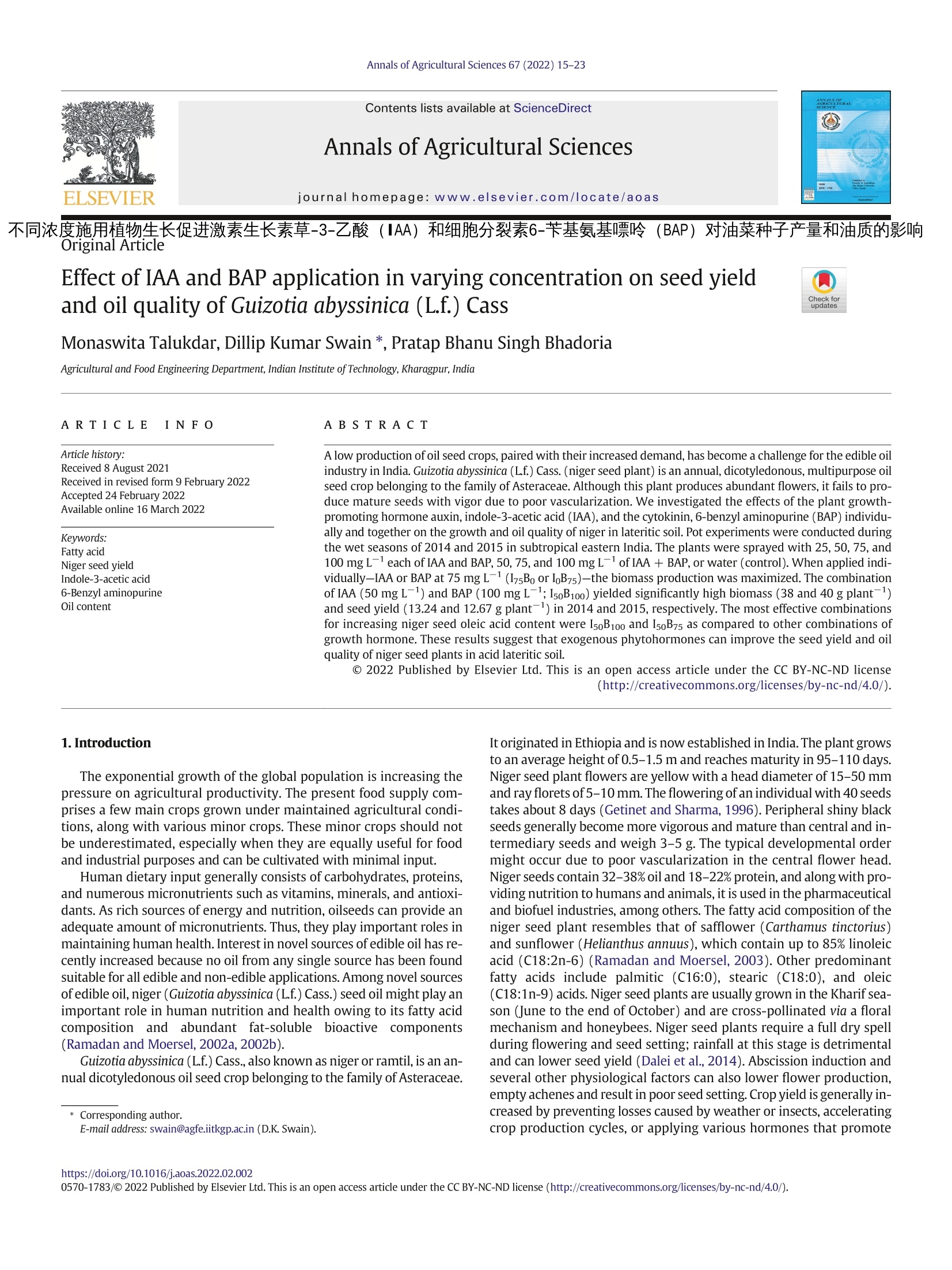
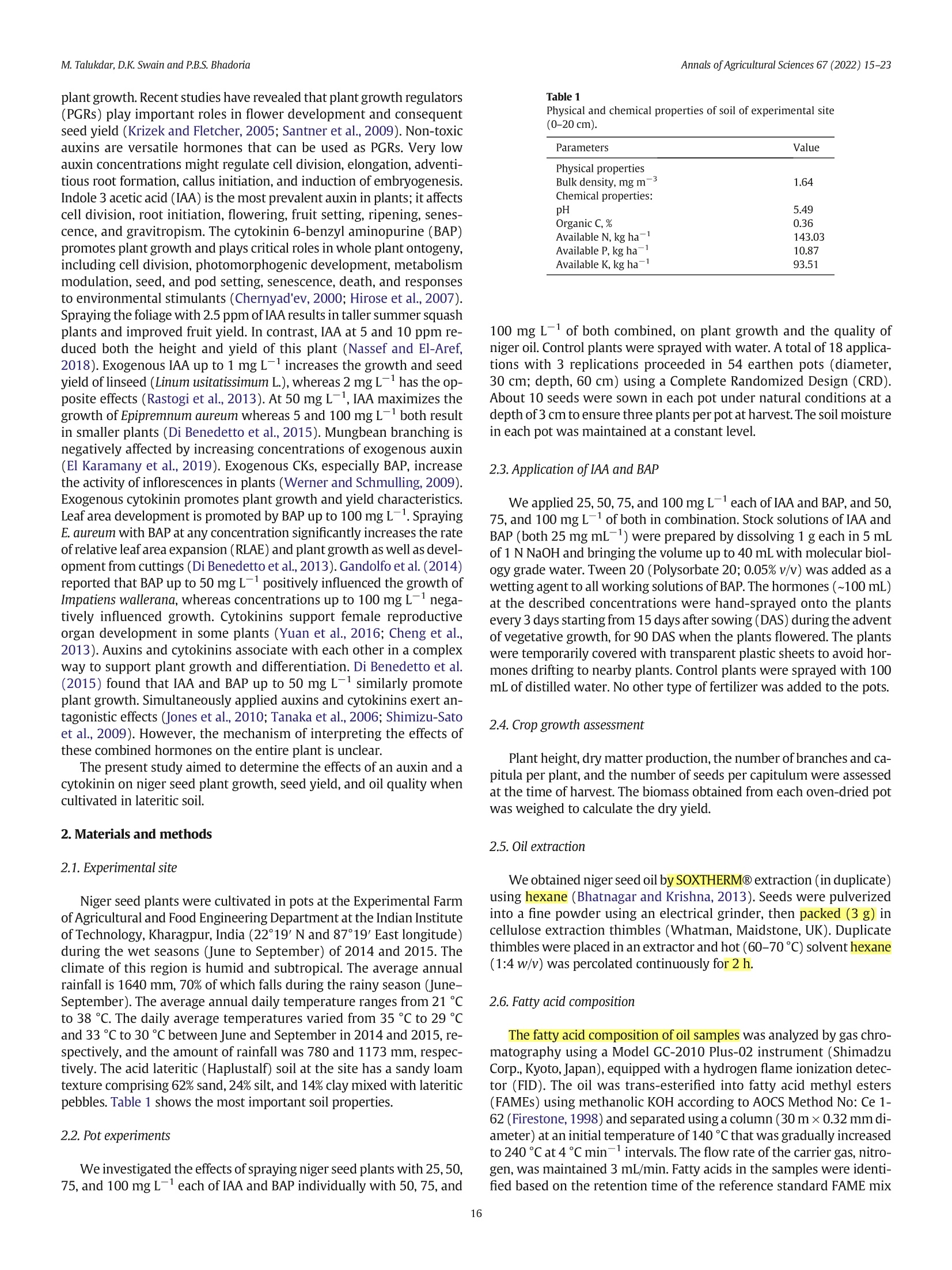

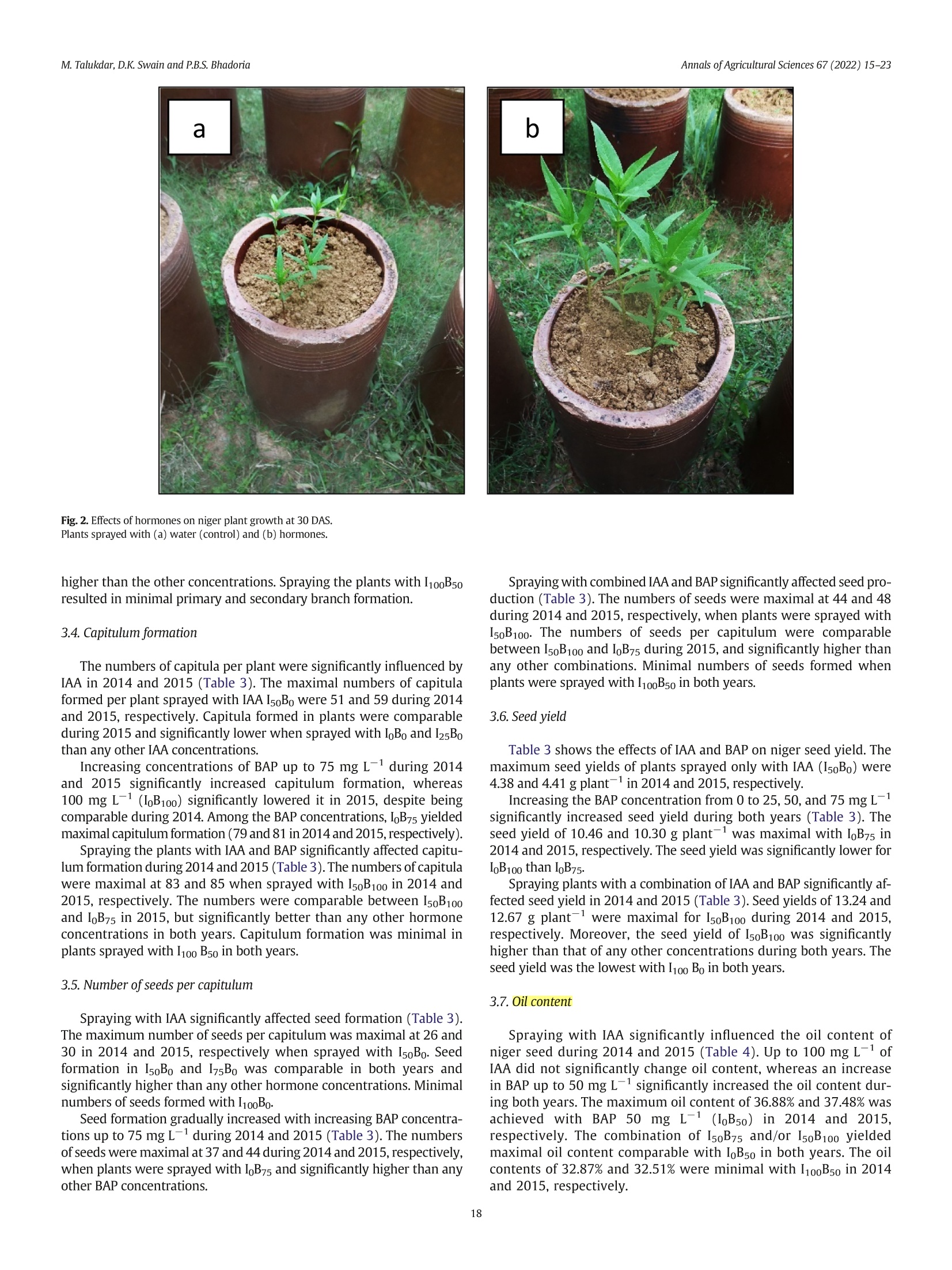



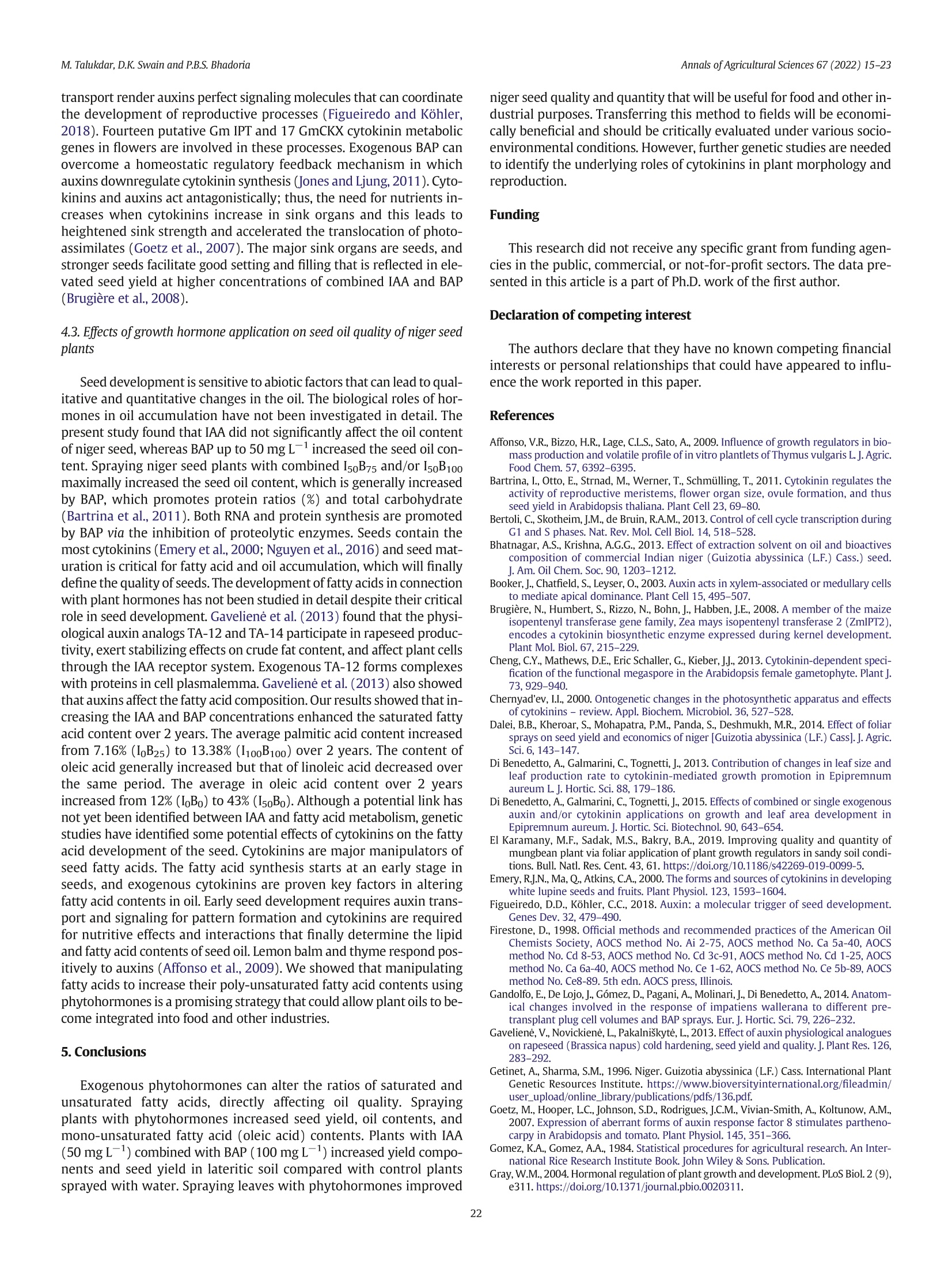
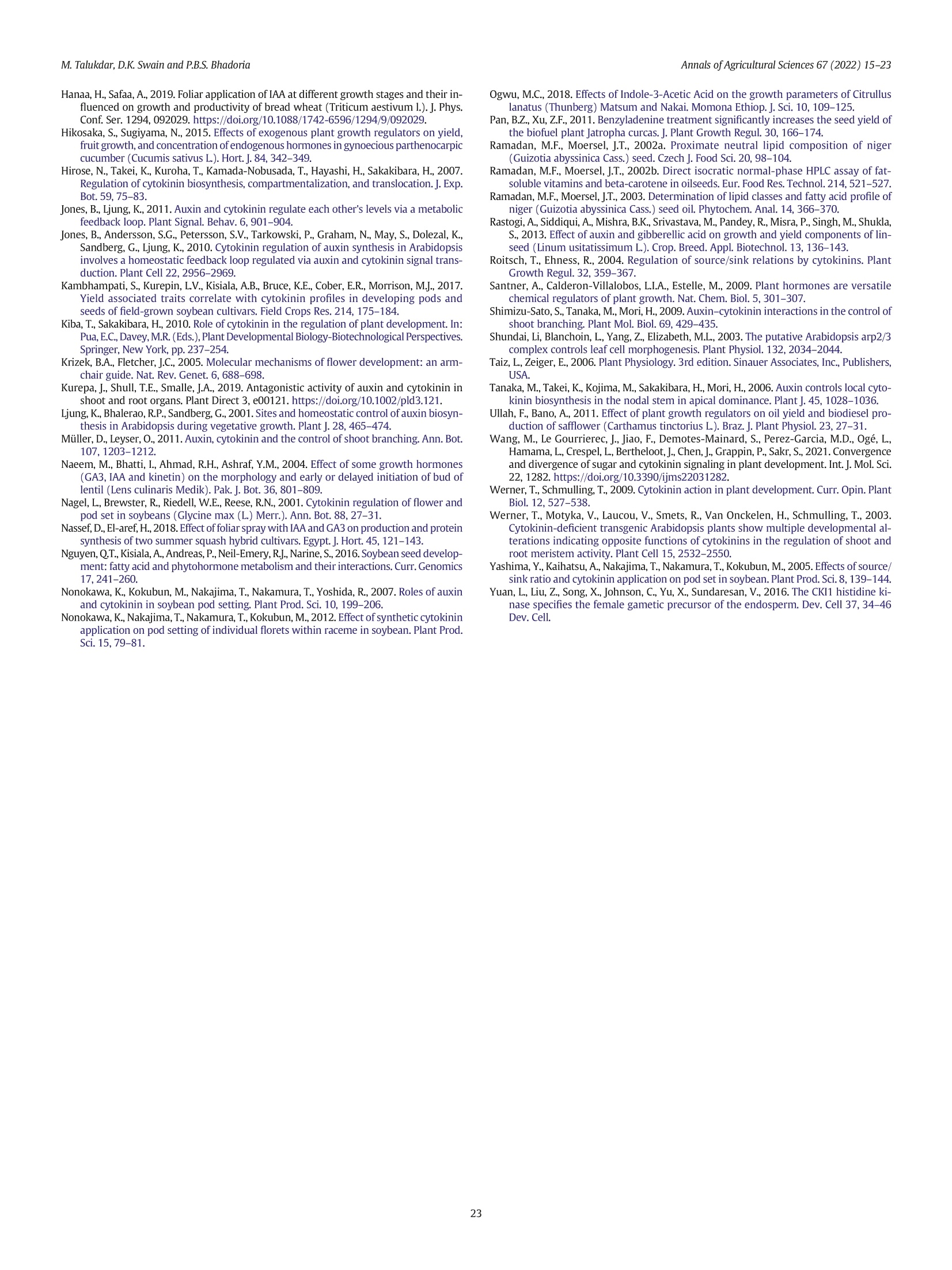
还剩7页未读,是否继续阅读?
产品配置单
中国格哈特为您提供《油菜种子含油率和脂肪酸含量的检测》,该方案主要用于种子中营养成分检测,参考标准--,《油菜种子含油率和脂肪酸含量的检测》用到的仪器有格哈特全自动快速索氏提取SOXTHERM、格哈特快速干燥仪STL56、德国加液器MM、滤纸筒
推荐专场
该厂商其他方案
更多










